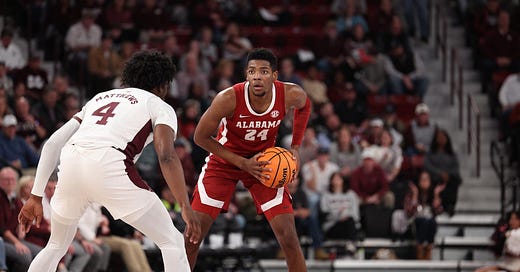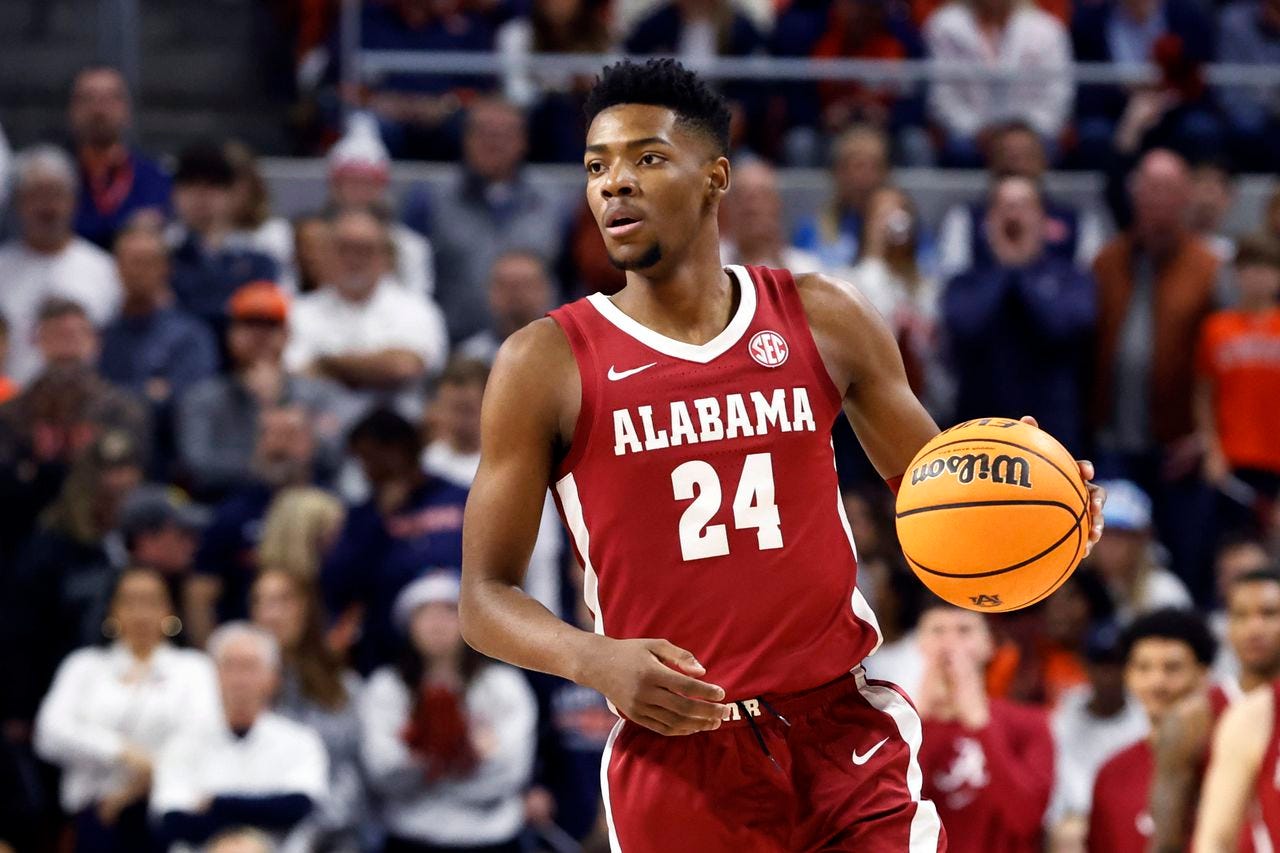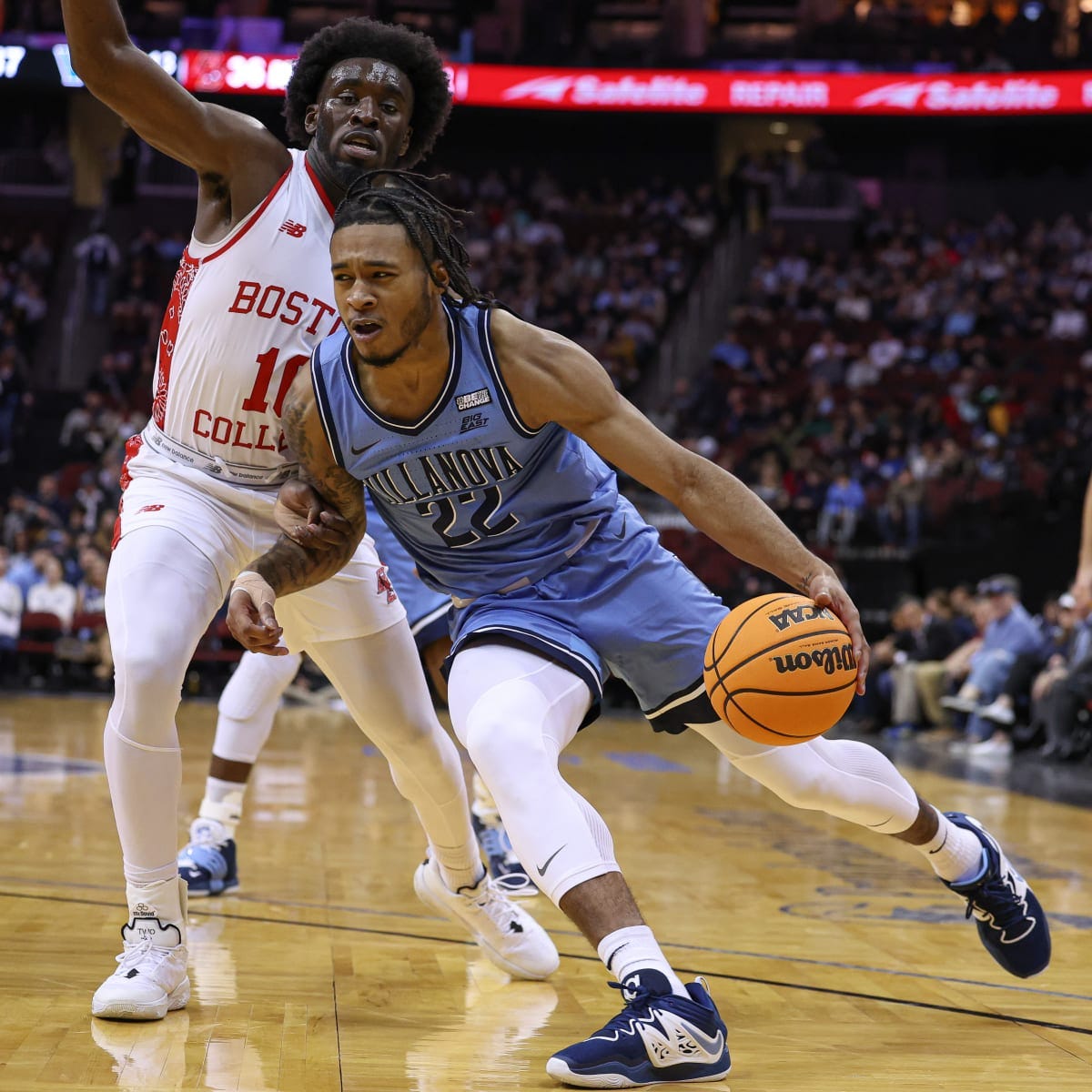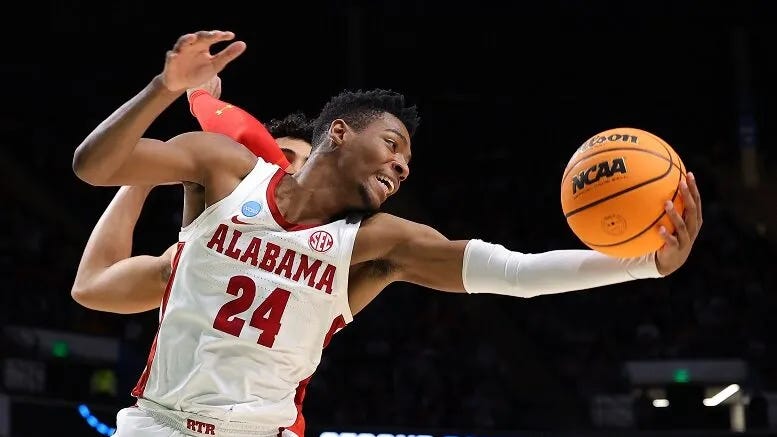Winging It: Brandon Miller vs. Cam Whitmore Film Breakdown (DraftPunk)
Arguably the top two wings in the draft are both slotted as top-five picks. So which one is better?
The top two wings in the draft in my opinion, Cam Whitmore and Brandon Miller, are both elite prospects at their positions who will almost certainly be top-five picks.
Miller starred on an elite Alabama Crimson Tide team, leading them in scoring en route to being a consensus first-team all-American, the SEC Player of the Year, and the SEC Tournament MVP.
Though Cameron Whitmore didn’t tear it up in the same way that Miller did, he still demonstrated elite athleticism and scalable, translatable traits during his lone season at Villanova. A consensus top-seven pick, Whitmore has the ability to be a star in the NBA as much as Miller does in my opinion.
The wing spot is one of the most important in basketball. Think about the amount of game-changing stars in the NBA that play this position: LeBron James, Kevin Durant, Kawhi Leonard, Paul George, Jimmy Butler, Jayson Tatum, Jaylen Brown, Brandon Ingram, OG Anunoby, Draymond Green, Khris Middleton…the list goes on.
So after all of these qualifiers, who’s the better wing prospect?
Let’s take a look at it.
• • • • •
Brandon Miller, Alabama (20.6 Years)
Brandon Miller, as previously mentioned, had an outstanding freshman season at Alabama, where he averaged 18.8 points, 8.2 rebounds, and 2.1 assists on .430/.384/.859 shooting splits, with a really good effective field goal percentage of 53.3%.
A five-star coming out of high school, he was ranked #17 on Rivals before committing to Nate Oats and the Alabama Crimson Tide. He quickly outperformed his ranking and became the premier college rookie; being first-team All-American as a true freshman is not common.
Part of a team with another first-round prospect in forward Noah Clowney, the Crimson Tide’s season was not perfect, for it was marred by the shooting death of a woman in Tuscaloosa, a case that involved the Alabama basketball team, and in particular, Brandon Miller.
Though he was cleared of wrongdoing, a cloud hung over the Crimson Tide program. Just how involved Miller was in this murder is a topic of debate (he was not the trigger man), but he wasn’t suspended, let alone charged with anything criminal.
I don’t want to speculate on this case, or make this piece about the legal issues facing Alabama basketball. Otherwise, reviews of Miller’s character have been glowing.
Offensively, Brandon Miller is an excellent three-point shooter, despite his falling off at the end of the season, which was due to injury. Watch his shooting form below on the deep shot – he’s especially effective off of the catch.
Here’s another one. Notice the quick release, and at 6’9, the high release point, making it difficult for defenders to contest the shot (especially undersized wing defenders).
The other thing to notice is the range – look how far out Miller is before he settles in and hits the attempt. Being able to shoot from further out than the three-point line is a valuable skill for spacing, as it requires a defender to pick up Miller nearly as soon as he crosses half court.
…Another one. This time, he puts it on the deck for a dribble before taking the three, which he nails. Once again, the speed with which he lets go of the ball makes it super difficult to anticipate defensively.
Though his feet aren’t perfect on his shot form, he’s still able to be a highly effective shooter from beyond the arc.
He’s not just a shooter, though – he has a decent enough handle at 6’9 to attack the rim occasionally as well. Though he’s a bit out of control with the dribble here, he’s still able to get to the rim and use his length and athleticism to slam it home over two defenders.
Here’s another fun one below. Watch the hammer in transition – it takes him just two steps from the three-point line before his take-off point for the dunk. Again, the length and athletic pop are evident in these driving situations.
Another underrated part of Miller’s skillset is his ability in the passing game – he averaged 2.1 assists, and though he averaged about the same amount of turnovers, he still demonstrated some natural feel in creating for others.
Watch the clip below to see a great feed from Miller down low to Noah Clowney. He recognizes that Clowney’s defender has left him to play the man on the perimeter; once he does, he throws a perfect laser to the power forward, who slams it home.
Here he is as the ball handler in the pick ‘n’ roll with Clowney. Watch the patience with which Miller takes the ball into the teeth of the defense, knowing that Clowney will be there for a lob once Miller reaches the restricted area.
He throws up the perfect alley and Clowney slams it home. Two points for Alabama.
Watch the kick-out below. Miller drives into the paint before throwing it behind his back to fellow freshman Rylan Griffen, who nails the three. Notice his vision here – he throws the pass right out of the reach of the LSU player.
Griffen gets the shot off before the Tigers defender can contest properly, and hits the attempt.
Here’s another example of his vision. He kicks it to Clowney at the three-point line, doing so off the dribble. Clowney hits the deep shot. Three points for ‘Bama.
Defensively, Brandon Miller is very effective, mostly due to his length when guarding on the perimeter. He averaged 1.8 stocks on the year (0.9 steals and 0.9 blocks), so his impact on this end is more important than scouts may have initially thought.
He illustrates his ability and timing on the rejection below in transition. The lift he gets when he takes off is super impressive, and the 6’9 frame with a 7’2 wingspan definitely helps.
Athleticism, size and timing? Solid shot-blocking prowess.
Once again below, he demonstrates an ability to block shots. The overall defense here is impressive – watch how he tracks the ball handler from the perimeter into the paint before rejecting KD Johnson’s shot.
It’s been mentioned ad nauseam, but the size here makes him such a valuable defensive player. The length helps him to keep with the ball handler when backpedaling, and puts him in position to contest the shot at the rim.
Here’s another rejection, this time in transition. The ability for him to come over and stuff the shot after tracking the ball down the floor demonstrates his timing.
Overall, there is a reason Brandon Miller is considered as high as the no. 2 pick. Whether or not to take Miller or Scoot Henderson is its own debate, but there is no doubt that Brandon Miller is a top-flight prospect that possesses a ton of valuable skills that translate to the next level.
The averages speak for themselves – he led the SEC in points per game as a freshman, and was fourth in rebounding in the conference as well. His size and athleticism lend themselves to this ability on top of defensive skills.
While I would take Scoot Henderson over Miller at no. 2, this isn’t to say that I don’t think Miller is worthy of a top-five pick; he absolutely is. I have him fourth on my board at the moment. The top four looks like this:
Victor Wembanyama, Metropolitans 92 (France)
Scoot Henderson, G-League Ignite (United States)
Amen Thompson, Overtime Elite (United States)
Brandon Miller, Alabama
As you can see, I think very highly of these two prospects.
Now, let’s take a look at Cam Whitmore.
• • • • •
Cam Whitmore, Villanova (18.9 Years)
Cam Whitmore, a freshman for Villanova this past season, averaged 12.5 points and 5.3 rebounds per game. The biggest knock on Whitmore is his very lacking distribution numbers, as he averaged an eye-opening (in the wrong way) 0.7 assists per game.
Considered a five-star prospect by Rivals and ranked 10th in the country, Whitmore was the first prized recruit of Kyle Neptune’s tenure at Villanova, who was replacing the legendary Jay Wright to take over the storied program that won two national titles in three years, in 2016 and 2018.
Whitmore would be yet another excellent Villanova product to enter the NBA, joining guys like Jalen Brunson, Josh Hart, Mikal Bridges, Kyle Lowry, Donte DiVincenzo, and Omari Spellman.
Despite lacking the stats and flash that Brandon Miller has, Whitmore has a very valuable skillset of his own that has NBA scouts in their feelings – he’s considered a top-five-to-seven pick for a reason.
What sticks out mostly about Cam Whitmore is his elite athleticism, better even than Miller’s, in my opinion. The 6’7, 230-lbs wing has a 6’9 wingspan that helps to aid him on the defensive end.
Watch the explosion on the jump here from Whitmore. He blows past the defender here before slamming it home to capitalize on the drive.
Here’s another look at his impressive leaping ability in transition. There’s not a ton to break down in this particular clip, but it’s indicative of Whitmore’s explosiveness.
One more fun one. The vertical here is so impressive. He ignites for the finish on the alley from Mark Armstrong, leading to two points for ‘Nova.
Cam Whitmore is more than just an athlete, however. Watch the post moves he displays below when scoring in the paint. He catches the inbounds pass, spins to his left, fakes back right, and then hits the lay-up on the double-clutch, scoring through contact and drawing the foul.
The strength stands out; the fact he scores through the foul shows coordination and body control, and indicates that his athleticism extends beyond simply vertical leaps and foot speed.
Another thing Cam Whitmore does well is attack the basket. He shot 64.5% at the rim this year, and has an underrated handle to get him there.
Watch the clip below to see an example of his attacking the rack. Notice the flurry of moves he puts on, not just with a live handle, but also once he’s picked up his dribble.
The post moves put him over the top as a wing, giving him an entirely new dimension in which to score.
Despite the (in my opinion warranted) criticism against Whitmore for his inability to create for others, he does have the ability to create for himself.
The clip here demonstrates his offensive skill, as he utilizes a fake, a crossover, and a step-back three. This is no easy shot – Whitmore has been underrated from deep this year, shooting 34.3% from beyond the arc on 4.2 attempts per game.
The handle and finishing touch are massive parts of Whitmore’s upside, major reasons he is as highly regarded as he is. Watch this take in transition below. Once again, the body control stands out.
This next clip is one of the most impressive finishes of the season in my opinion. Before the truly outrageous EuroStep, watch the easy behind-the-back dribble as he crosses half court. This clips is illustrative of his handle and his ability to score at the rim.
Defensively, Cam Whitmore is elite. His body control and strength contribute to this on top of a good basketball IQ on this end. This is one of his selling points without a doubt.
Below, he demonstrates some serious timing with the rejection on Seton Hall’s KC Endefo. He absorbs the contact in the paint before raising up and stuffing the attempt without leaving his feet; Villanova then recovers the ball.
Here’s a good look at his perimeter defense. Watch him initially deflect the pass before swarming the recipient. He then uses quick hands to knock the ball loose again before another Villanova player recovers it, leading to a fast-break opportunity.
Here’s a clip of his off-ball defense. Playing defense in the post, Whitmore is guarding 7’0 center Christian Richardson, yet easily bats the entry pass away, resulting in a live-ball turnover. His skill in creating fast-break opportunities is one of his most valuable assets.
As far as playmaking goes, Whitmore had pretty mediocre numbers. Though his 0.7 assists per game are not fully indicative of this playmaking ability, it’s still a bit of an indictment on his overall creation. Combine this with 1.6 turnovers per game, and you realize that Whitmore is pretty deficient in this area.
Despite these numbers, there were flashes of passing skill from time to time. In the clip below, he recognizes the space that Brandon Slater has down low. The post defender comes up to play the ball handler (Whitmore), who then whips it to Slater at the rim. Slater then finishes the play; two points for the Wildcats.
Here’s Whitmore’s making a decent read in the pick ‘n’ roll. Eric Dixon sets the screen at the three-point line before rolling to the basket. When the two defenders stay with Whitmore, he anticipates the space Dixon will have on the roll, and gets him the ball. Dixon banks it in off the glass.
Generally, however, Whitmore reacts slowly on reads offensively. It’s a serious problem for a wing prospect. For example, of all wing prospects in this draft, Whitmore ranks behind:
• Brandon Miller, Alabama (2.1 APG)
• Ausar Thompson, Overtime Elite (6.1 APG)
• Gradey Dick, Kansas (1.7 APG)
• Jett Howard, Michigan (2 APG)
• Dariq Whithead, Duke (1 APG)
• Brice Sensabaugh, Ohio State (1.4 APG)
• Bilal Coulibaly, Metropolitans 92 (France) (1.4 APG)
• Sidy Cissoko, G-League Ignite (3.1 APG)
• Maxwell Lewis, Pepperdine (2.8 APG)
• Julian Strawther, Gonzaga (1.3 APG)
• Jaime Jaquez, UCLA (2.4 APG)
• Nikola Djurisic, KK Mega Basket (Serbia) (3.7 APG)
• Ben Sheppard, Belmont (2.9 APG)
• Julian Phillips, Tennessee (1.4 APG)
• Jordan Walsh, Arkansas (0.9 APG)
• Keyontae Johnson, Kansas State (2.1 APG)
• Ricky Council IV, Arkansas (2.3 APG)
• Emoni Bates, Eastern Michigan (1.4 APG)
• Jordan Miller, Miami FL (2.7 APG)
• Marcus Bagley, Arizona State (1.5 APG)
There are probably a couple more guys you could categorize under “wing” as well that would have better distribution numbers than Cam Whitmore had this year. It’s a glaring hole in an otherwise pretty high-floor prospect’s skillset.
Despite the lacking play-making, Whitmore checks just about every other box you would want outside of sharpshooting. He’s an insane athlete, an excellent, impactful defender, a great slasher and finisher, and versatile on both sides of the floor.
To me, he’s an easy top-seven pick; had his creation been better, he’d be a top-five prospect. Still, this is something the Villanova product can improve on, and with NBA instruction, he may be able to become a salvageable passer.
• • • • •
Who’s the better prospect?
To determine the better prospect, we’re going to break down their games into seven categories, then tally them. Whichever player finishes with more points is the”better” prospect.
• • • • •
Scoring Upside – Brandon Miller
This one is fairly obvious, mostly having to do with Miller’s ability to shoot the ball from deep. He shot it nearly 5% better than Whitmore did this season from deep, and just overall has a better chance to be a scoring threat at the next level.
While Whitmore is a better driver, and better at creating his own shot, the shooting skills can’t be ignored with Miller. He was one of the best three-point threats in the country in his freshman year, and did so at a high volume (7.5 attempts/game).
His shooting form is beautiful, despite the “happy feet” he occasionally displays upon landing from the jumper. The quick release and point of release make the shot super difficult to guard.
• • • • •
Creation – Brandon Miller
This was a pretty obvious one. Miller averaged 3x the amount of assists that Whitmore did, and as far as the eye test goes, demonstrated better vision and anticipation in the passing game.
Though he did average more turnovers (2.2 to 1.6), his assist percentage is 12.9%, compared to Whitmore’s 6.4%. Miller has simply displayed much more feel in this aspect so far in their careers.
• • • • •
Handle – Cam Whitmore
Cam Whitmore’s handle is very good for a wing – and, combined with his ability to finish, this makes him an extremely dangerous player, both in the half court and in transition. His athleticism and foot speed make him a nightmare to guard in the fast-break, whether he has the ball or not.
When he does have the ball, he’s able to get to the basket easily with his tight handle. He does so below here before finishing off the glass.
• • • • •
Athleticism – Cam Whitmore
While Brandon Miller is a really good athlete, Whitmore is an elite athlete, even for this very athletic draft class. He’s extremely explosive, to recycle a word from earlier in this piece. The leaping ability and body control are attributes that contribute to his high-level finishing ability.
He can sky for alleys and dunks in transition. With the aforementioned handle, he’s able to attack the basket as well. Watch how he does so below before the epic hammer.
• • • • •
Defense – Brandon Miller
Both of these guys are excellent defenders in their own ways. While Whitmore is a better athlete, Miller has better size, so the methods with which they defend opponents vary.
Miller averaged 1.8 stocks to Whitmore’s 1.4, and while both players impacted defensively by creating live-ball turnovers to help kick into transition, I think it’s difficult to determine which player was better on this end.
However, once you look at the advanced stats, you see how much they favor Miller. In defensive box plus/minus, or DBPM, Miller scored 4.3 on the year to Whitmore’s 2.5. Miller also had 2.9 defensive win shares, or DWS, while Cam Whitmore had 1.2.
Sometimes, the eye test and regular stats don’t completely convince me on an argument. Advanced stats to serve a purpose, I promise.
The upside of a 6’9 wing with a 7’2 wingspan defensively is very enticing. Watch how he defends the ball handler below to see a glimpse of his potential on this end.
• • • • •
Rebounding – Brandon Miller
Miller averaged 8.2 boards to Whitmore’s 5.3 per, and that enough should probably convince you that Miller is a better rebounder. He’s also got a size and standing reach advantage, which counts for quite a bit when cleaning the glass.
He also edges Whitmore in advanced stats in this category, though the margin is much less significant than the raw rebounding numbers. Miller’s rebounding percentage is 12.6% to Whitmore’s 12.1% – Whitmore is better on the defensive glass (20.1% to 17.7%), while Miller leads Whitmore in offensive rebounding percentage, 6.7% to 3.7%.
While the advanced numbers make it much closer than it appears, I have to lean Miller in this particular category.
• • • • •
Intangibles (Age, Size, BBIQ, Fouls Drawn) – Brandon Miller
Age – Cam Whitmore firmly has the advantage here, as he is shy of 19 at the moment, while Brandon Miller is 20.6 years old. Whitmore is 18.9 years old.
Size – Brandon Miller has the edge as far as size goes; I’ve mentioned it several times, but Miller stands at 6’9 with a 7’2 wingspan, while Cam Whitmore is 6’7 with a 6’9 wingspan. Miller is a bigger prospect with better physical traits.
Basketball IQ – I have to award this one to Brandon Miller as well, primarily due to the discrepancy in assist numbers. Miller has an advanced feel for the game compared to Cam Whitmore, whose offensive reads are behind at the moment.
Fouls Drawn – Miller wins this category as well, drawing 4.6 foul shots per game to Whitmore’s 2.5 per. He also shot significantly better from the line, converting nearly 86% from the stripe to his counterpart’s 70.3%.
• • • • •
Final Tally:
Brandon Miller – 5
Cam Whitmore – 2
Looking at everything equally, it’s pretty clear that Brandon Miller is the superior prospect. That isn’t to say he’ll end up being a better player, but as far as scalable traits and things that translate to the next level, Miller has a more pro-ready skillset.
While Whitmore’s athleticism gives him a sky-high upside, Miller undoubtedly has a higher floor and will most likely make a bigger impact earlier in his career than Cam Whitmore.
The lack of playmaking will really hurt the Villanova wing – so much so that it could possibly keep him off the floor at times. I’m not saying Brandon Miller is Magic Johnson, but he’s at the very least a capable passer, while Whitmore is very inconsistent.
There is a reason Miller is rumored to go at no. 2 (regardless of how wrong I think they are in picking Miller over Scoot Henderson, but that’s for another article). Miller is a big, highly skilled, pretty athletic, multitalented wing that has drawn comparisons to Paul George and Khris Middleton. He seems like a safe pick in the top five, even if Henderson has a (much) higher ceiling.
Despite his flaws, I still like Cam Whitmore as a top-seven pick, and could see his going as high as four (though his being drafted this high would surprise me a bit). He has a super high ceiling because of the elite athletic prowess and burgeoning skillset. His shooting isn’t great (also not terrible), but that can be improved.
These are two of the best players in a very strong draft at a very important position. Where these prospects end up and how their careers unfold will be a huge point of interest for me over the next few seasons.
My next piece, Shooters Shoot: Jordan Hawkins vs. Gradey Dick, will be out in the next 2-3 days. Subscribe to the site to get articles sent directly to your email (it’s free and you won’t get spammed).
• • • • •
@KeenanWomack on Twitter.








